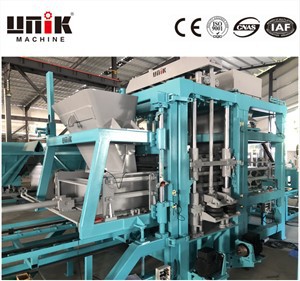What is a Hollow Block Automatic Machine?
2025-01-13
The construction industry has seen remarkable innovations in machinery that streamline the production of construction materials. Among these innovations is the Hollow Block Automatic Machine, an advanced piece of equipment designed to manufacture high-quality hollow blocks for construction purposes. These machines have revolutionized the way building materials are produced, providing a fast, efficient, and cost-effective solution. In this blog, we’ll explore the functionality, types, and key benefits of Hollow Block Automatic Machines.
What is a Hollow Block Automatic Machine?
A Hollow Block Automatic Machine is a type of automated equipment used to produce hollow blocks, which are commonly used in the construction of buildings, roads, and infrastructure projects. Hollow blocks are favored due to their strength, lightweight nature, and excellent insulation properties. The automatic machine facilitates the production process by performing tasks such as mixing raw materials, shaping blocks, and curing them without the need for manual labor.
The machine typically uses materials such as cement, sand, aggregates, and water to create the blocks. Through automated operations, the machine ensures consistent quality, uniform shape, and high production efficiency.
How Does a Hollow Block Automatic Machine Work?
The production process of hollow blocks involves several key steps, all of which are automated by the machine:
1. Material Mixing: The raw materials (cement, sand, aggregates, water) are loaded into the machine’s hopper. The machine mixes the materials in the correct proportions to create a uniform slurry.
2. Molding: The mixed material is then transferred into molds. The hollow block machine has automated systems to fill, compact, and shape the mixture into the desired block format. Depending on the machine, it can produce a variety of sizes and shapes.
3. Vibration and Compaction: The molds undergo vibration and compaction, ensuring that the blocks are dense, uniform, and free from air pockets. This step is crucial for achieving strong, durable blocks.
4. Curing: After molding, the blocks are removed from the molds and undergo a curing process. Depending on the machine, curing may be done via steam or air-drying.
5. Automatic Stacking: Once the blocks are cured, the machine can automatically stack them on pallets or other platforms for storage or transportation to construction sites.
Types of Hollow Block Automatic Machines
There are several types of Hollow Block Automatic Machines, each designed to meet different production capacities and requirements. The most common types include:
1. Semi-Automatic Machines: While not fully automated, these machines perform most tasks automatically, such as mixing and molding. However, operators may need to assist with loading materials or stacking blocks.
2. Fully Automatic Machines: These machines handle the entire process from material mixing to stacking with minimal human intervention. They are more efficient and capable of higher production outputs, making them ideal for large-scale manufacturing.
3. Mobile Machines: Some manufacturers offer mobile hollow block machines that can be easily transported to construction sites. These are particularly useful for on-site block production.
Hollow Block Automatic Machines have revolutionized the way construction materials are produced. They offer unparalleled efficiency, consistency, and cost-effectiveness. Whether used in large-scale manufacturing plants or mobile units for on-site production, these machines play a crucial role in modern construction. Their ability to automate complex tasks and produce high-quality blocks makes them an invaluable tool in the construction industry.



